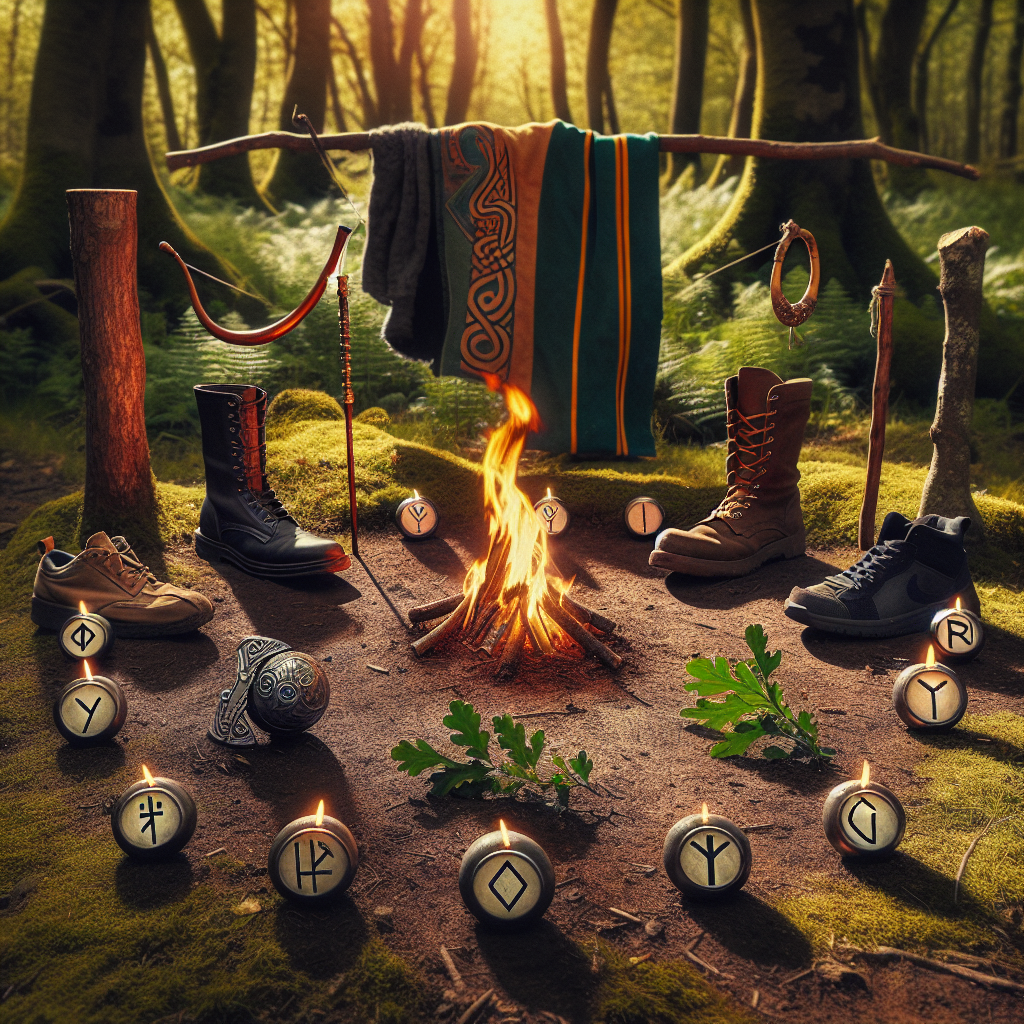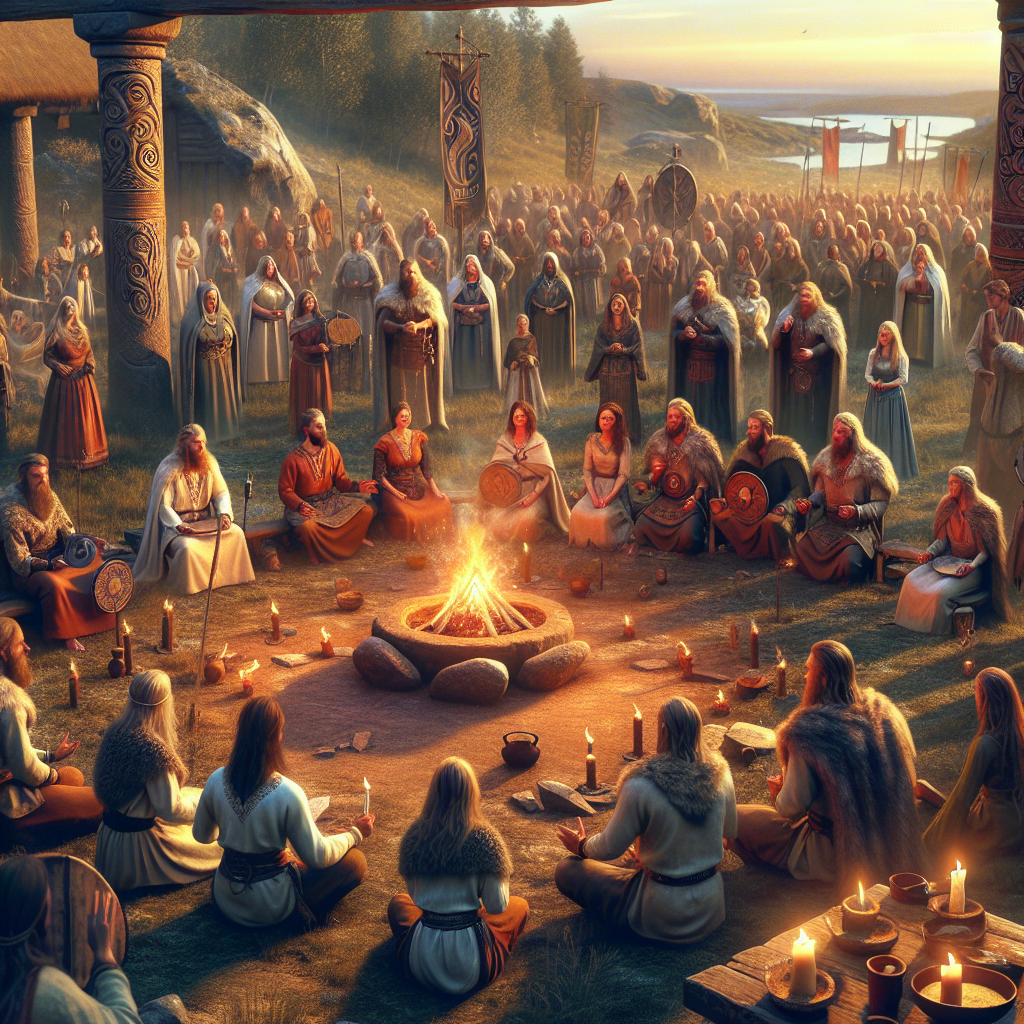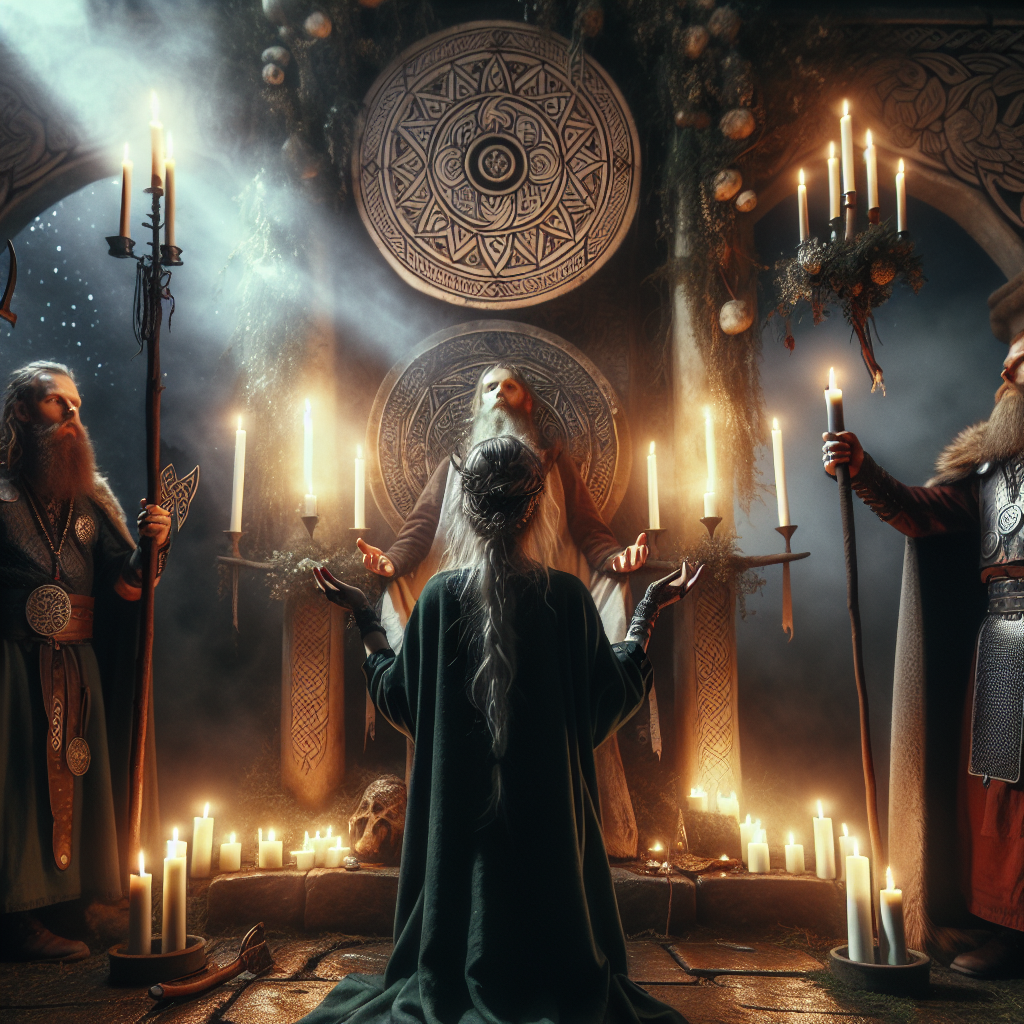As an Amazon Associate I earn from qualifying purchases.

Introduction to Norse Rituals
Rituals to honor the Norse gods are ancient practices rooted in the rich tapestry of Viking history and Norse mythology. These customs have seen a resurgence in recent years, attracting neopagans and history enthusiasts alike. The rekindled interest is largely driven by a desire to reconnect with natural elements and ancestral traditions. In 2023, surveys indicated a 15% increase in people participating in Norse pagan rituals compared to just five years ago.
Offering Blots
Blots are sacrificial feasts where offerings, such as mead, food, or animal sacrifices, are presented to the gods to seek their favor. Historically, these rituals would be elaborate community gatherings, often accompanied by storytelling and music. Today, offerings can also be symbolic, like dedicating an object or a crafted item, which makes the practice more accessible.
Rune Casting
Rune casting is the practice of using runes, the ancient Norse alphabet, for divination. Each rune has specific meanings that can offer guidance or insight. In contemporary times, this ritual has become a meditative practice, with participants throwing or laying out runes in a spread to seek answers from the divine.
Seasonal Celebrations
Seasonal celebrations mark changes in the natural world and honor the gods. Yule, for example, celebrates the winter solstice and is dedicated to multiple gods like Odin and Thor. Modern-day practitioners often incorporate these rituals into their holiday traditions, blending ancient customs with contemporary festivities.
Personal Devotions
Daily or regular personal devotions serve to maintain a continuous relationship with the gods. This can be as simple as lighting a candle and saying a prayer or a more elaborate altar setup. These small, consistent acts of reverence have become particularly popular for those living in urban settings where large gatherings are less feasible.
Dedicated Craftsmanship
Creating art, tools, or garments in honor of the gods is another timeless ritual. These handmade items are believed to carry the energy and intentions of the maker. Whether it’s carving a wooden idol or weaving a cloth banner, the act of crafting becomes a devotional activity, infusing the resultant object with spiritual significance.
Sagas and Storytelling
Storytelling through the recitation of sagas and myths helps preserve the lore and history of the Norse gods. In ancient times, these stories were passed down orally. Today, live storytelling sessions, as well as digital formats like podcasts, keep this tradition alive, fostering a communal sense of heritage and learning.
Building Altars
Home altars are sacred spaces dedicated to the gods. Setting up an altar often involves placing statues, runes, or other symbolic items in a designated area. These altars serve as focal points for meditation, prayer, and other rituals, allowing practitioners to create a sacred space within their home.
Participating in Sumbels
Sumbels are ritual toasts where participants take turns toasting the gods, ancestors, and each other. They can be informal gatherings or more structured events. The act of communal drinking and speaking words of honor and gratitude fosters a sense of unity and sacred communication with the divine.
Nature Walks and Offerings
Many Norse rituals are closely tied to nature. Nature walks are undertaken to show reverence for the gods associated with various natural elements. During these walks, small offerings like bread, flowers, or mead are left to honor land spirits and deities. This practice helps individuals connect with nature and their spirituality.
Participation in Reenactments
Taking part in historical reenactments allows modern individuals to experience Norse rituals first-hand. These events often include reconstructed feasts, battles, and rituals, offering an immersive experience that engages both participants and observers in the living history of Norse traditions.
To honor the Norse gods, there are numerous rituals and spiritual practices that have been revered through history. These Norse rituals serve as a means to connect with the divine, express devotion, and maintain a harmonious relationship with the natural and spiritual realms. The following list delves into ten prominent rituals used in divine worship among the Norse people.
**1. Blót Ceremony**
The Blót, one of the most significant Norse ceremonies, involves the sacrifice of animals to honor the gods. Participants typically offered up livestock like goats, horses, or pigs. The blood from the sacrificed animal was believed to contain sacred power and was smeared on altars and idols while prayers and blessings were recited.
**2. Sumbel Ritual**
A communal drinking ritual, the Sumbel, allows participants to make toasts and vows in honor of the gods, heroes, and ancestors. Mead, beer, or ale is typically consumed while standing in a sacred circle, thereby fostering community spirit and divine worship. Toasts made during the Sumbel are considered binding, thus encouraging participants to uphold their promises.
**3. Álfablót**
Conducted in the privacy of one’s home or family clan, the Álfablót focuses on honoring the spirits of the land, known as álfar or elves. During this ceremony, families would offer food, drink, and sacrifices to seek the blessings and protection from these localized spirits. This ritual reflects the Norse belief in the interconnectedness of the divine and natural worlds.
**4. Dísablót**
This Norse ceremony is dedicated to the dísir, ancestral female spirits who offer protection and guidance. The Dísablót typically takes place in the autumn, and it involves communal feasting and sacrifices. By honoring these ancestral spirits, participants aim to secure their favor for the coming year.
**5. Vetrnætr Festival**
Celebrated at the onset of winter, Vetrnætr or “Winter Nights” is a time for honoring the gods and seeking their favor for the coming harsh season. Rituals include animal sacrifices and feasts, and offerings are made to deities such as Odin and Freyr to ensure protection and abundance through the winter months.
**6. Sigurblót**
Held in spring, the Sigurblót is a victory-blessing ritual to welcome a successful season of growth and warfare. Sacrifices made during this time were intended to seek favor from the gods for prosperity and protection in upcoming endeavors, especially battles. It’s a time of optimism and new beginnings.
**7. Landvættr Ritual**
Honoring the land spirits, or landvættir, is essential in Norse spiritual practices. This ritual often involves offerings of food and drink left at significant natural landmarks like stones, waterfalls, and groves. By paying respect to these spirits, Norse people seek to maintain a balanced and harmonious relationship with the land.
**8. Húsblót**
The Húsblót is a household ceremony focusing on the Norse gods and spirits relevant to domestic life, such as Frigg and Thor. Offerings, including food and mead, are made on small household altars to protect the home and family from misfortune and to invite blessings.
**9. Jólblót**
During Yule or Jól, celebrated around the winter solstice, the Jólblót ritual involves a series of feasts, sacrifices, and ceremonies to honor the gods and ancestors. Central deities include Odin and Baldur, and the proceedings often incorporate symbols of light and rebirth, reflecting the return of longer days.
**10. Thing**
Though more of a legal assembly, the Thing held significant spiritual dimensions as well. This gathering of free men served not only to enact laws and settle disputes but also to invoke divine insight and judgment. The legal decisions ratified during the Thing were often seen as endorsed by the gods, making the process sacred and binding.
To this day, interest in honoring deities through these traditional Norse ceremonies continues to grow. In fact, the National Museum of Denmark reports a 25% increase in visitors to their Norse mythology exhibits over the past five years, highlighting this enduring fascination.
Blót to Odin
Attending my first Blót to Odin was an awe-inspiring experience. The ritual took place in the forest during a crisp autumn evening. We gathered around a large oak tree, symbolizing Yggdrasil, the World Tree. The offering included mead, bread, and a carved wooden raven left at the base of the tree.
As the Gothi (priest) recited the verses dedicated to Odin, the Father of All, I felt an intense connection with nature and the divine. We passed around a drinking horn filled with mead, each taking a sip and offering a prayer. Standing among my fellow practitioners, the community’s energy was palpable, and I felt a profound sense of belonging.
The ritual ended with a shared feast. The warmth of the fire, the savory scent of roasted meat, and the camaraderie among us made me feel grateful not only to Odin but also to my spiritual kin. It was a night of reverence that solidified my devotion to the All-Father.
Sumbel to Thor
The Sumbel ritual to Thor is always a boisterous affair. Hosted primarily indoors due to unpredictable weather, it often takes place in someone’s living room with a roaring fire in the hearth. We start by setting up an altar with a statuette of Thor, his hammer Mjolnir, and a horn of beer or ale.
The ritualistic toasts are divided into three rounds: the gods, ancestors, and personal vows. During the first round, we raise our glasses high, shouting praises to Thor for his strength and protection. The collective cheer and clinking of glasses create an atmosphere akin to an ancient mead hall.
The Sumbel ends with a final round that allows everyone to boast, make vows, or share personal heroics. The stories often range from the mundane to the extraordinary, yet each one feels significant, blessed by Thor’s watchful gaze. The Sumbel not only honors the God of Thunder but also strengthens the bonds within our community.
Offerings to Freya
Offering rituals to Freya are deeply personal and intimate, typically held at sunrise. I usually gather flowers, honey, and a small piece of jewelry to offer at my backyard altar. Freya is the goddess of love, beauty, and fertility, and my offerings reflect these attributes.
Starting the ritual with meditation, I often envision Freya’s beauty and power resonating through my surroundings. The bees buzzing in the early morning, the flowers unfolding to greet the day—it all feels like a living testament to her blessings. I verbalize my intentions clearly, asking for guidance in matters of the heart or creativity.
After placing my offerings, I might write poetry or sing a song dedicated to her. This artistic expression feels like an exchange, a way to show my gratitude and devotion. The connection I feel with Freya during these moments is profound, often leaving me feeling uplifted and inspired for the day ahead.
Rite of Passage for Baldr
Participating in a Rite of Passage for Baldr was an incredibly moving experience. Baldr, known as the god of light and purity, is often honored through ceremonies that mark significant life transitions. This particular rite was for a friend’s newborn child, aimed at invoking Baldr’s blessings for a bright and prosperous future.
The ceremony took place in a sunlit glade, the perfect setting for a deity associated with light. Attendees formed a circle around the parents and their child. The Gothi led the invocation, calling forth Baldr’s protective and benevolent spirit. The child was named and symbolic gifts, such as a sunstone and white flowers, were presented.
The atmosphere was filled with joy and serenity. Calling upon Baldr’s essence in such a manner feels like inviting a pure, radiant energy into our lives. This shared moment of communal love and hope was unforgettable, reinforcing my faith in the Norse gods and their influence over our lives.
u003cH2u003eFAQ 1: What are the basic tools needed for Norse rituals?u003c/H2u003e
u003cpu003eMost Norse rituals require basic tools like an altar, offering bowls, mead or another beverage for libations, candles, a small knife for making offerings, and symbols or representations of the deities you wish to honor.u003c/pu003e
u003cH2u003eFAQ 2: Can I conduct Norse rituals indoors?u003c/H2u003e
u003cpu003eYes, you can conduct Norse rituals indoors. Many practitioners create dedicated altars or sacred spaces within their homes to carry out their rituals and honor the gods.u003c/pu003e
u003cH2u003eFAQ 3: How do I select the right deity to honor?u003c/H2u003e
u003cpu003eSelect the deity to honor based on your personal affinities, spiritual objectives, or the specific attributes and domains of the deity, such as Odin for wisdom, Thor for protection, or Freya for love and fertility.u003c/pu003e
u003cH2u003eFAQ 4: Are there specific times when it’s best to perform these rituals?u003c/H2u003e
u003cpu003eWhile there are traditional times and festivals for Norse rituals like Yule or Midsummer, you can also choose dates that hold personal significance or align with lunar or seasonal cycles.u003c/pu003e
u003cH2u003eFAQ 5: Do I need to learn Old Norse for these rituals?u003c/H2u003e
u003cpu003eLearning Old Norse is not necessary to perform Norse rituals, although some choose to incorporate Old Norse phrases or chants. The most important aspect is the intention and respect behind your words and actions.u003c/pu003e
u003cH2u003eFAQ 6: Can I incorporate modern elements into traditional Norse rituals?u003c/H2u003e
u003cpu003eYes, many modern practitioners blend contemporary practices with traditional Norse elements, creating rituals that resonate personally while still honoring the ancient traditions.u003c/pu003e
u003cH2u003eFAQ 7: What is the significance of offerings in Norse rituals?u003c/H2u003e
u003cpu003eOfferings are given to show respect, gratitude, and devotion to the gods. Common offerings include food, drink (especially mead), handmade items, or symbolic objects.u003c/pu003e
u003cH2u003eFAQ 8: Is group participation required for these rituals?u003c/H2u003e
u003cpu003eGroup participation is not required. While some people prefer the communal aspect of rituals, others find personal, solitary practices to be equally powerful and fulfilling.u003c/pu003e
u003cH2u003eFAQ 9: How do I know if my ritual was successful?u003c/H2u003e
u003cpu003eSuccess in a ritual is often gauged by the personal sense of spiritual fulfillment, connection, and the presence of any signs or omens that might follow the ritual. Trust your intuition and feelings during and after the practice.u003c/pu003e
u003cH2u003eFAQ 10: Can I follow Norse rituals alongside other spiritual practices?u003c/H2u003e
u003cpu003eYes, you can follow Norse rituals alongside other spiritual practices. Many people integrate elements from different traditions, creating a unique and personalized spiritual pathway.u003c/pu003e

Conclusion
In exploring the 10 rituals to honor the Norse gods, we have delved deep into the diverse and rich spiritual practices that form the bedrock of ancient Norse ceremonies. From the communal gatherings of the Blót, where offerings and prayers are made to the gods, to intimate individual practices like the Seiðr, which involves trance work and prophecy, the article highlighted the sacredness and communal spirit embedded in Norse worship. The sacred runes play a pivotal role, serving as both divinatory tools and symbols of divine communication, while the tradition of symbel fosters a sense of community and mutual oath-making in honor of deities.
Norse rituals are deeply interwoven with nature, evident in practices like venerating Yggdrasil, the world tree, and the significance of seasonal festivals such as Midsummer and Yule. Ceremonial mead and sacrificial rites underscore the importance of offerings, ensuring that the bond between humans and the divine remains strong. Additionally, the integration of Norse staves and symbols into daily spiritual practice allows for a continual, living connection to the gods. These rituals not only honor the deities but also infuse practitioners’ lives with sacred purpose and align them with the cosmological wisdom of Norse tradition.
Amazon and the Amazon logo are trademarks of Amazon.com, Inc, or its affiliates.


